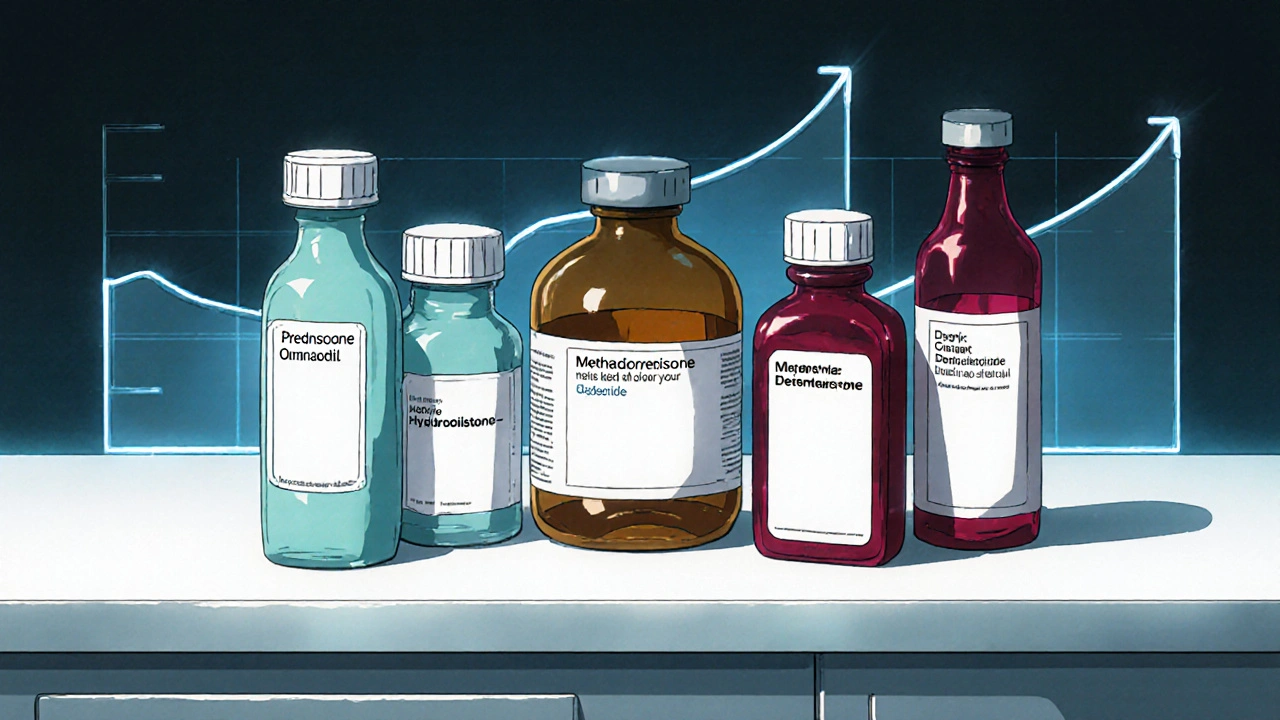Steroid Dose Converter
Convert Between Steroid Medications
Calculate equivalent doses between different steroid medications based on their potency ratios. This tool helps understand how much of one steroid equals another.
Equivalent Dose
Enter values to see equivalent dose
When doctors prescribe a steroid, they often start with Omnacortil, the brand name for prednisolone. But it’s not the only option on the shelf. If you’re trying to understand how it stacks up against other anti‑inflammatory drugs, you’ve come to the right place. This guide walks through the key differences, when each drug shines, and what side‑effects you might expect.
What is Omnacortil (Prednisolone)?
Omnacortil is a synthetic glucocorticoid, marketed as prednisolone, used to suppress inflammation and immune reactions. It works by mimicking cortisol, the hormone your adrenal glands release during stress. Because it’s taken orally, it’s handy for conditions like arthritis, asthma flare‑ups, and certain skin disorders.
Why look at alternatives?
Every steroid has its own potency, half‑life, and side‑effect profile. Some patients can’t tolerate prednisolone’s impact on blood sugar, while others need a longer‑acting drug for chronic issues. Knowing the trade‑offs helps you and your doctor pick the right tool for the job.
Key criteria for comparing steroids
- Potency - how strong the anti‑inflammatory effect is per milligram.
- Duration of action - short‑acting vs. long‑acting.
- Metabolic impact - effects on blood glucose, bone density, and weight.
- Route of administration - oral, injectable, inhaled, or topical.
- Typical indications - conditions where the drug is most often prescribed.

Quick‑look comparison table
| Drug | Potency (relative to 5 mg prednisolone) | Half‑life | Route | Typical Uses | Key Side‑effects |
|---|---|---|---|---|---|
| Prednisolone (Omnacortil) | 1× | 2‑3 h | Oral | Arthritis, asthma, skin disorders | Elevated glucose, weight gain, mood swings |
| Hydrocortisone | 0.5× | 1‑2 h | Oral, topical, IV | Adrenal insufficiency, mild inflammation | Less metabolic impact, but needs frequent dosing |
| Methylprednisolone | 1.25× | 2‑4 h | Oral, IV | Severe autoimmune disease, spinal cord injury | Higher risk of bone loss |
| Dexamethasone | 25× | 36‑72 h | Oral, IV, ophthalmic | Cerebral edema, chemotherapy‑induced nausea | Strong suppression of HPA axis, insomnia |
| Budesonide | ≈1× (lung‑targeted) | 12‑24 h | Inhaled, oral | Asthma, COPD, IBD | Fewer systemic effects when inhaled |
| Prednisone (pro‑drug) | ≈1× (converted to prednisolone) | 2‑3 h | Oral | Similar to prednisolone, often used in US | Same metabolic concerns as prednisolone |
When Omnacortil is a good fit
If you need a fast‑acting oral steroid that reaches therapeutic levels quickly, prednisolone is a solid pick. Its moderate potency means you can fine‑tune the dose without risking the extreme effects seen with dexamethasone. For short bursts-like a 5‑day course for an asthma flare-it balances power and safety well.
Scenarios where alternatives shine
- Long‑term management: Dexamethasone’s long half‑life reduces daily pill counts for chronic conditions, but you must monitor bone health closely.
- Localized treatment: Inhaled budesonide delivers the steroid straight to the lungs, limiting systemic exposure for asthma patients.
- Patients with diabetes: Hydrocortisone’s milder metabolic impact can be easier on blood sugar, though the dosing schedule is more frequent.
- Severe autoimmune disease: Methylprednisolone IV packs a stronger punch, often used in hospital settings for rapid control.

Side‑effect checklist you can use
- Track blood glucose weekly if you’re on prednisolone or a similar glucocorticoid.
- Watch for mood changes-irritability or euphoria can appear within days.
- Ask your doctor about bone density scans after three months of high‑dose therapy.
- Check for facial rounding ("moon face") and easy bruising as signs of excess dosage.
- Never stop a steroid abruptly; taper down under medical supervision.
How to discuss alternatives with your doctor
Bring this checklist to your appointment. Explain any existing conditions-like diabetes, hypertension, or osteoporosis-that might sway the choice. Ask questions such as:
- "Can we use an inhaled steroid instead of an oral one for my asthma?"
- "If I need a longer‑acting option, how will that affect my bone health?"
- "Are there lifestyle steps to lessen the metabolic impact of prednisolone?"
Being clear about your concerns helps the clinician match the drug to your health goals.
Bottom line
Omnacortil (prednisolone) remains a versatile, mid‑potency oral steroid, perfect for short‑term bursts and conditions that need quick control. Alternatives like dexamethasone, budesonide, and methylprednisolone fill the gaps when you need longer action, localized delivery, or a different side‑effect profile. Use the comparison table, side‑effect checklist, and doctor‑talk tips to decide which option fits your situation best.
What makes prednisolone different from prednisone?
Prednisone is a pro‑drug that the liver converts into prednisolone. The end result is essentially the same, but some doctors prefer prednisolone for patients with liver impairment because it skips the conversion step.
Is budesonide safer for long‑term asthma control?
When delivered by inhaler, budesonide targets lung tissue directly, leading to far fewer systemic side‑effects than oral prednisolone. It’s often the first‑line choice for chronic asthma.
Can I switch from prednisolone to dexamethasone for a chronic condition?
You can, but the dose isn’t a simple 1‑to‑1 conversion because dexamethasone is about 25 times more potent. Your doctor will calculate an equivalent dose and monitor for bone loss and HPA‑axis suppression.
What should I do if I experience severe mood swings on prednisolone?
Report the changes immediately. Your physician may lower the dose, add a mood‑stabilizing medication, or switch to a steroid with a different central nervous system profile.
How long does it take for prednisolone to start working?
Most patients notice a reduction in inflammation within 24‑48 hours. Peak effects usually appear around day three, which is why short courses often span five to seven days.

Diane Thurman
Look, prednisolone is the so‑called "middle‑ground" steroid, but it's often overrated. People think it's safe just because it's oral, but the metabolic side‑effects can be nasty. If you ignore the glucose spike, you're basically inviting trouble. Honestly, the brand name Omnacortil just masks the fact that it's a standard prednisolon with all its baggage.
Sarah Riley
Quantitative risk‑benefit analysis indicates a suboptimal therapeutic index for prednisolone in chronic applications. The pharmacodynamic profile is subpar relative to dexamethasone.
Tammy Sinz
While the data you cite is solid, remember that patient adherence hinges on tolerability. If a drug makes someone miserable, no amount of efficacy matters. I'm asserting that clinicians should prioritize agents with fewer neuropsychiatric effects when alternatives exist. Empathy for the patient's daily life is as crucial as the biochemical potency.
Christa Wilson
Great points! 😊 Keep the optimism alive-there are plenty of options that balance power and peace of mind. 🌟
John Connolly
Prednisolone remains a cornerstone in glucocorticoid therapy because of its predictable pharmacokinetics.
Its oral bioavailability approaches 100%, which simplifies dosing compared to some injectable alternatives.
For acute exacerbations of asthma, a typical 5‑day taper can bring symptoms under control within 48 hours.
The drug’s moderate potency allows clinicians to fine‑tune the dose without immediately courting the severe side‑effects seen with dexamethasone.
However, one must remain vigilant about blood‑glucose elevations, especially in patients with pre‑existing diabetes.
Routine monitoring of fasting glucose every week during high‑dose courses is advisable.
Bone health should also be on the radar; a baseline DEXA scan before a prolonged regimen can spot early demineralization.
If a patient reports mood swings or irritability, tapering the dose or adding a low‑dose antidepressant may be warranted.
Compared with hydrocortisone, prednisolone offers a longer half‑life while keeping metabolic disruption relatively modest.
In contrast, methyl‑prednisolone IV provides a rapid, high‑intensity pulse that is useful for severe autoimmune flare‑ups but carries a higher risk of osteoporosis.
Budesonide inhalers target the lungs directly, virtually eliminating systemic cortisol‑like effects, making them the first choice for chronic asthma maintenance.
Dexamethasone’s 36‑hour half‑life is advantageous for patients who struggle with daily pill burden, yet its potent HPA‑axis suppression demands calcium and vitamin D supplementation.
When switching between steroids, remember that potency conversions are not linear; a 5‑mg prednisolone dose roughly equals 0.2‑mg dexamethasone.
Educating patients about these equivalencies prevents accidental over‑suppression and related complications.
In practice, I often start with prednisolone for short‑term control and reserve the longer‑acting agents for cases where adherence is a genuine concern.
Sajeev Menon
Ths is a good summry, but dont forget to mention the cgeneration of endogenus cortisol deppression. If u keep giving prednsolone long term, the body will shut down its own production – thats a big thing to monitor. Also, watch out for th e enhanced risk of infections, especially in diabetics.
Emma Parker
Totally see you on this.
Joe Waldron
Interesting perspective, indeed; however, one must also consider the socioeconomic factors-cost, insurance coverage, and access-all of which heavily influence patient compliance; moreover, the variance in individual metabolism can cause unpredictable plasma levels, leading to either sub‑therapeutic effects or amplified adverse events!
Wade Grindle
From a cultural standpoint, it's worth noting that in many regions patients prefer inhaled options because they align better with daily routines and have fewer stigmas attached. This observation can guide clinicians toward more patient‑centered prescribing.